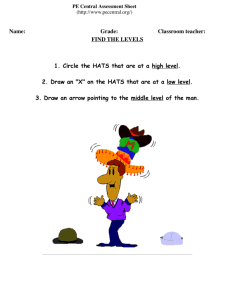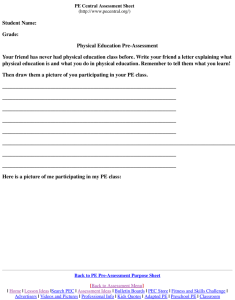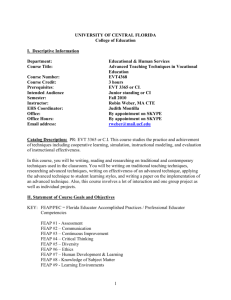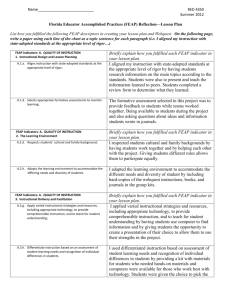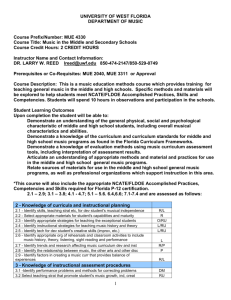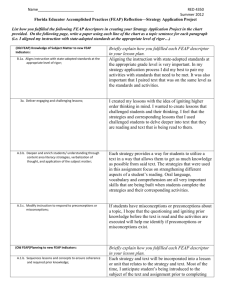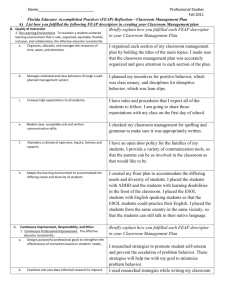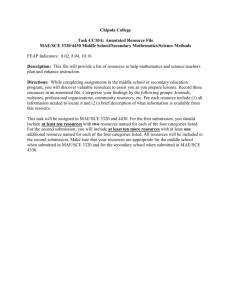UNIVERSITY OF CENTRAL FLORIDA - UCF College of Education
advertisement
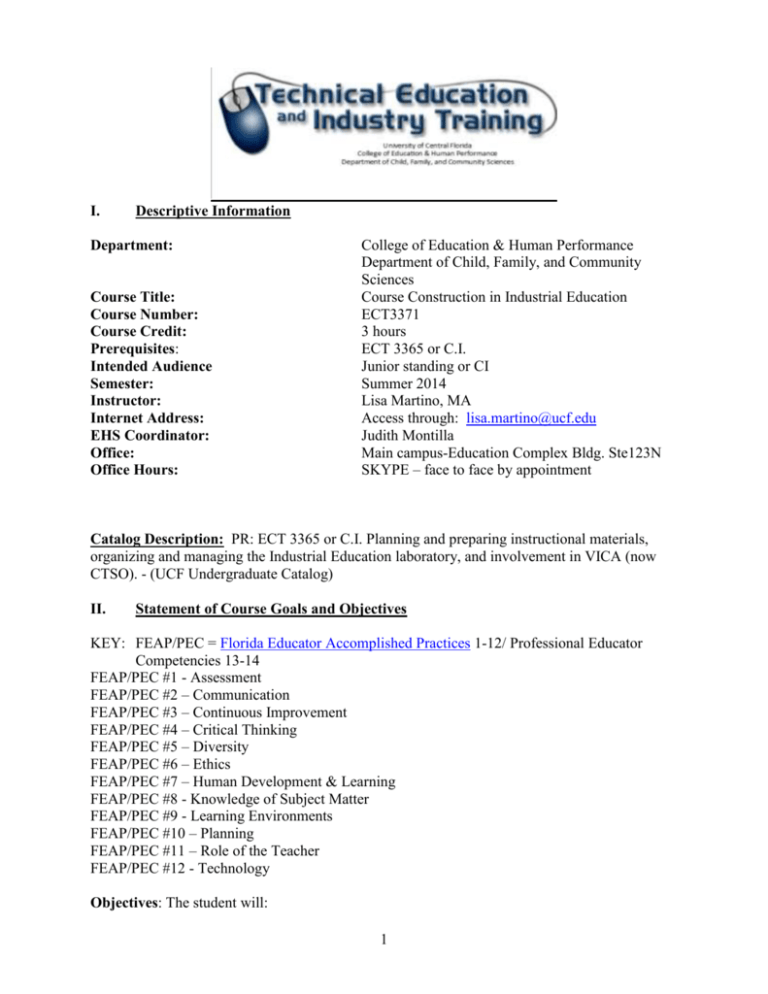
I. Descriptive Information Department: Course Title: Course Number: Course Credit: Prerequisites: Intended Audience Semester: Instructor: Internet Address: EHS Coordinator: Office: Office Hours: College of Education & Human Performance Department of Child, Family, and Community Sciences Course Construction in Industrial Education ECT3371 3 hours ECT 3365 or C.I. Junior standing or CI Summer 2014 Lisa Martino, MA Access through: lisa.martino@ucf.edu Judith Montilla Main campus-Education Complex Bldg. Ste123N SKYPE – face to face by appointment Catalog Description: PR: ECT 3365 or C.I. Planning and preparing instructional materials, organizing and managing the Industrial Education laboratory, and involvement in VICA (now CTSO). - (UCF Undergraduate Catalog) II. Statement of Course Goals and Objectives KEY: FEAP/PEC = Florida Educator Accomplished Practices 1-12/ Professional Educator Competencies 13-14 FEAP/PEC #1 - Assessment FEAP/PEC #2 – Communication FEAP/PEC #3 – Continuous Improvement FEAP/PEC #4 – Critical Thinking FEAP/PEC #5 – Diversity FEAP/PEC #6 – Ethics FEAP/PEC #7 – Human Development & Learning FEAP/PEC #8 - Knowledge of Subject Matter FEAP/PEC #9 - Learning Environments FEAP/PEC #10 – Planning FEAP/PEC #11 – Role of the Teacher FEAP/PEC #12 - Technology Objectives: The student will: 1 1. From a review of the State of Florida, Department of Education, Curriculum Frameworks and Course Standards identify one specific course you feel qualified to teach. (FEAP/PEC 3) 2. Compare the listed Curriculum Frameworks student requirements to specific industry requirements noting similarities and differences. (FEAP/PEC 3) 3. Propose revisions to the Florida Frameworks. (FEAP/PEC 3) 4. Describe the facts, benefits, organization, and rewards of a CTSO for teachers and students OR Report your accounts/interviews as a teacher/advisor or judge at an event of a National Leadership Conference for a CTSO. (FEAP/PEC 11) 5. Identify and describe apprenticeship opportunities for a selected occupation as it relates to a broad career area. (FEAP/PEC 11) 6. Identify laws and regulations relating to apprenticeship opportunities. (FEAP/PEC 11) 7. Develop a plan for implementing an apprenticeship program. (FEAP/PEC 10) 8. Describe the requirements for qualifications and certification to be a teacher in your area. (FEAP/PEC 3) 9. Describe a new trend in business or industry using Web resources. (FEAP/PEC 3) 10. Propose a new technique for the classroom based upon a new trend. (FEAP/PEC 3) 11. Evaluate why the new technique proposed is important. (FEAP/PEC 3) 12. Identify requirements for a student's entry into one self-selected occupational area using Web resources made available. (FEAP/PEC 8) 13. Describe and summarize the requirements related to preparing students concerning worker characteristics, and experience/specific. (FEAP/PEC 8) 14. Identify state, and federal safety requirements for the chosen occupational area. (FEAP/PEC 8) 15. Compare and contrast safety issues from Curriculum Frameworks and Industry Requirements. (FEAP/PEC 8) 16. Develop a lesson plan to assist students in developing basic academic skills. (FEAP/PEC 2, 8, 10) 17. Reflect on accomplishments during the term of this course and post what has been learned and what has influenced you as a teacher or trainer. (FEAP/PEC 3) 18. Demonstrate how to use the Web to gather references and cite the reference using APA style. (FEAP/PEC 12) III. Required Texts and Readings Textbook: No Text required – World Wide Web resources Supplementary Materials: None required IV. Academic Course Requirements 1. Activities (80%) Your written work must be professional in appearance. It should be free from grammatical and spelling errors. It is very important that you work be posted on or before the published due date and on time. You will have until a specific date and time noted for each course. Please see the grading “procedures” provided below. 2. Reflection Essay Final Examination (15%) 2 There will be one overall final exam at the end of the course. It is weighted at 15% of the total course grade. Pay attention to course Schedule. Repost is not available for final essay examination. 3. Professionalism (5%) Part of being a professional in education is modeling behaviors. You are or will be a professional educator/trainer and as such are expected to adhere to quality standards in the (virtual) classroom. Five points will be assigned about midway through the course. Your professionalism in the virtual classroom will be monitored and reviewed as to the extent you: o Participate regularly in weekly discussion topics. Meaning that you are accessing the course at least once every two days to read postings and to reply to peers and instructor. Each week your instructor will post a question for the class. Your response should be thought-provoking and well researched. o Interact regularly with peers and instructor through course mail o Demonstrate appropriate net-etiquette o Provide on-line assistance to peers in the course V. Administrative Course Requirements Attendance: This course places a strong emphasis upon the interaction of the students therefore you are expected to attend all class sessions. The failure to attend class will negatively affect your Professionalism grade. Late Assignments: Please see the professor if you are turning in an assignment late (please see the "Grading Procedures" section below). VI. Evaluation and Grading System All of our courses use the same grading scale and follow the same grading procedure. This is based on specific principles: 1. The work you do is performance--based, assignments are actual or simulate real world work. 2. There is one opportunity to revise selected work within one week of scored date. 3. Work is assessed using criterion and not norm-referenced; a "normal curve" is not used in calculating grades or activity scores in our courses. 4. Exams, as such, are weighted lower than in most other college courses, hence we attempt to treat adult learners as adult learners. There are no make up exams. 5. A "participation" component termed "Professionalism" is included in each course to simulate required participation in real-world work. Each student earns points throughout the course. Listed below is the grading scale used in the course. Points given to each assignment are seen in the course's "Schedule." 3 Grading scale: Letter Grade Percentage A 94 - 100 B 87 - 93 C 80 - 86 D 73 - 79 F 72 and below The faculty in this program has chosen NOT to adopt plus or minus policy for grades. Grading Procedures: The following are the grading procedures used in determining your grade in each course. 1. Late Assignments Assignments need to be posted to Discussions by 11:55 p.m. Eastern Standard Time on the due date. A late assignment is graded as follows: Beginning after 11:55 p.m., one (1) point is deducted for every day that the assignment is posted late. Any time you feel you might be falling behind in the course, it is best to contact the intern or myself to discuss your situation. No assignments will be accepted after the final day of class. 2. Reposting If you did not receive 100% of the points assigned to an activity, you have the chance to repost the activity within 5 days after receiving the grades (please see the "Grades" section below). However, reposting does not apply to an activity that requires you to post a response to another student. In other words, you are not able to go back into an activity and post a response to another student’s posting after the activities due date. Reposting only applies to a written assignment posting that did not receive full point value (i.e. a posting of a rubric for your course). There is no reposting or make up for final examination essay. 3. Posting of Grades Grades are completed one week after the due date. For example, if your assignment was due on Sunday at 11:55 p.m., then the grades are posted by the following Monday morning OR sooner. You can view your grades by selecting the "My Grades" link. If you do not see your grade after the week, please notify me. 4 VII. Major Topics of the Course Florida Curriculum Frameworks Industry Requirements CTSOs (Career & Technical Student Organizations) Apprenticeships Teacher Qualifications & Certifications Occupational Requirements Developing a Lesson Plan VIII. Tentative Course Outline Release Points Date Activities Due Dates Sunday 11:55 p.m. Orientation, Introduction & Syllabus Quiz Date 0 Date Activity 1 State Curriculum Date 10 Date Activity 2 Student Organizations (CTSO) Date 10 Date Activity 3 Apprenticeship Date 15 Date Date 10 Date Teacher Qualifications and Certification Professionalism – As per the Rubrics in the discussion post Date 5 Date Activity 5 Occupational and Teaching Trends Date 10 Date Date 10 Date Date 15 Date Date 15 Date Activity 4 Activity 6: Occupational Requirements Activity 7 Develop a Lesson Plan Part A- Post the lesson plan Develop a Lesson Plan Part B - Respond to 1 other student's postings. Reflection Essay Final Examination 5 IX. Bibliography ACTE Online (n.d.). Career & technical student organizations. Retrieved on March 13, 2011 from http://www.acteonline.org/ctso.aspx?terms=student+AND+organizations+AND+%28+%40date modified+%3E+2007%2f05%2f14+%29+ Division of Human Resources/EEO Certification Office (n.d.) Career and technical education. Retrieved on March 13, 2011 from https://www.ocps.net/es/hr/employ/certification/Pages/Car.aspx Florida Department of Education (n.d.-a). Apprenticeship. Retrieved on March 13, 2011 from http://www.fldoe.org/workforce/apprenticeship/ Florida Department of Education (n.d-b.). Educator certification: Steps to certification. Retrieved on May 17, 2007 from http://www.fldoe.org/edcert/steps.asp Florida Department of Education (n.d.-c). Frameworks. Retrieved on March 13, 2011 from http://www.fldoe.org/workforce/dwdframe/ Florida Department of Education (n.d.-d). Administrative rule 6A-4.060 : Specialization requirements for certification in industrial arts-technology education (Grades 6-12) Retrieved on May 12, 2007 from http://www.fldoe.org/edcert/rules/6A-4-060.asp Florida Department of Education (n.d.-e). Workforce education. Retrieved on March 13, 2011 from http://www.fldoe.org/workforce/publicat.asp Florida Department of State: State Library and Archives of Florida (2007). Florida administrative weekly and Florida administrative code. Retrieved May 12, 2007 from https://www.flrules.org/gateway/ChapterHome.asp?Chapter=6a-4 Office of Vocational and Adult Education (n.d.). Career and technical student organizations. Retrieved on May 10, 2007 from http://www.ed.gov/about/offices/list/ovae/pi/cte/vso.html?exp=0 The Florida Legislature (2006.) Department of education apprenticeship. Retrieved on May 16, 2007 from http://www.oppaga.state.fl.us/profiles/2121/ U.S. Department of Labor (n.d.) Training. Retrieved on May 11, 2007 from http://www.dol.gov/dol/topic/training/apprenticeship.htm U.S. Department of Labor (n.d.). Occupational Outlook Handbook, 2010-2011. Retrieved on March 13, 2011 from http://www.bls.gov/oco/ Vaughn, P., Vaughn, R., & Vaughn, D.L. (1990). Handbook for advisors of vocational student organizations, (2nd edition). Athens, GA: AAVIM. 6 Conceptual Framework UCF, College of Education Conceptual Framework Te ch nic al / Revised: 08-17-04 i ofe ssi Pro on fes al sio Ac co n a mp l lish ed E C nta tio n I F E R N Accomplished Professional Pr a c t ica l or i e nta tio n Professional Educator/ Practitioner O ow l Pr e-P r Kn ori e ills n tifi c al on ssi ofe -Pr al Pre on ssi ed ofe plish Pr m co Ac L T atio ent i r o tic nis a m Hu Sc ien Sk ed ge Ac em ad n tio a t n r ie co Pre-Professional Dispositions Critical / Social orientation The graphical representation of our conceptual framework is based on basic geometric shapes that aptly portray key aspects of the framework: At the heart of the model are three concentric circles creating a “target” for graduates from all of our professional education programs. The core objective (“bull’s eye”) is becoming a Professional Educator, an achievement that requires continuous reflective practice (middle ring) and professional development aligned with applicable national, state, and institutional standards (outer ring). The three triangles represent three broad levels of professional development: Pre-professional, Professional, and Accomplished (note the physical progression indicating that professional development always moves in the direction toward Professional Educator). These triangles also represent the three major dimensions of professional development: knowledge, skills, and dispositions. 7 Integrated throughout all aspects of our conceptual framework and thus reflected as a circle-inmotion is our circle of core beliefs (Research Base, Best Practice, Life-Long Learning, Ethics, Social Justice, Equity, Diversity, Caring, Democracy, Academic Standards, and High Quality Education). The outer pentagon of the conceptual framework represents five broad orientations regarding the preparation of professional educators (Academic, Teaching/Scientific, Practical, Critical/Social, and Humanistic), which serve as a broad foundation for the framework. The UCF Creed Integrity, scholarship, community, creativity, and excellence are the core values that guide our conduct, performance, and decisions. Integrity I will practice and defend academic and personal honesty. Scholarship I will cherish and honor learning as a fundamental purpose of my membership in the UCF community. Community I will promote an open and supportive campus environment by respecting the rights and contributions of every individual. Creativity I will use my talents to enrich the human experience. Excellence I will strive toward the highest standards of performance in any endeavor I undertake. Major Milestones of Program Webcourses Technical Competencies Just as you would not embark on a long-distance trip without knowing something about the vehicle you are traveling in, you should not enroll in web courses without acquiring some skills of the vehicle used to transfer your knowledge to the instructor. Following are some competencies you must achieve before leaving today. Be sure to be checked off by the instructor or a mentor to show that you have the basic knowledge to use Blackboard. You must be able to do the following: 1. Access the Webcourses course(s) in which you are enrolled. 2. Log into MY UCF with your username and password. 3. Access course components. 4. Post comments to Discussion Topics. 5. Enter Chat room and post comments. 6. Access Course Mail to select specific addresses, write notes or respond to mail. 7. Find mail in your Inbox and the Outbox 8. Copy and paste to and from Blackboard 9. Include URL's in your postings. (copy & paste) 10. Access "My Grades" 11. "My Participation". 8 Writing Papers & Posting References - Procedures APA STYLE Below are sites where you can go to find information on how to write using APA style and how to cite an electronic resource. 1. American Psychological Association. (2003). APA Online website APA Style.org retrieved on August 8, 2005 at http://www.apastyle.org/ . 2. APA Style Resources. (n.d.) Retrieved on August 8, 2005 at http://www.psychwww.com/resource/apacrib.htm ** Sometimes you have to try the site a couple of times or copy the URL and paste it. But it does work. From the selections that are offered to you, I prefer the link listed below… 3. The Arthur C. Banks Library at Capital Community College (2004, June). A guide for writing research papers based on styles recommended by the American psychological association. Retrieved on August 8, 2005 at http://webster.commnet.edu/apa/index.htm 4. Degelman, D. (2000-2011). APA style essentials. Retrieved from the Vanguard University website on March 13, 2011 at http://psychology.vustatic.com/faculty/douglas-degelman/apastyle/ **has examples of papers to view HOW TO CITE AN ELECTRONIC SOURCE USING APA American Psychological Association. (2003). APA style.org, Electronic Resources retrieved on May 8, 2005 at http://www.apastyle.org/elecsource.html HOW TO RESEARCH THE INTERNET 1. Go to www.google.com 2. Select "Advanced Search" (hyperlink found on the right of the searching field) 3, Fill in the information needed to minimize your searching time. Select the "Advanced Search Tips" at the top of the page for help *TIP: A good scholarly resource is the “Journal of Technology Education” from the Virginia Tech (2011) retrieved on March 13, 2011 at http://scholar.lib.vt.edu/ejournals/ej-search.html . This site has several articles on technology education. HOW TO ORGANIZE A PAPER The purpose of me providing you this site is because I want you to know that I will be grading you on the organization of your paper. Your paper should contain a thesis statement that contains your topic sentence, the main body (all of the paragraphs should reflect what is in your topic sentence) and a conclusion. 9 Steps in writing your Essay. (n.d.) Retrieved from the Importwarehouse.com site on August 8, 2005 at http://www.importwarehouse.com/mrsboysen/Students/steps.PDF Team Strategies When you first heard that you would be working in a team, you might have thought "oh no!" Understandable, you might have had a bad experience in the past with a team project in another class or at work. However, learning how to work in a team environment is beneficial to you for problem solving, working under the pressure of a time limit, and learning how to work with others. Also, team work is a reality of the workforce. Learning some of the strategies given below is useful for the present class and a possible future job requirement. STEPS TO BEGINNING A TEAM PROJECT 1. Make contact in your team discussion group. 2. Discuss the topics below (Team Rules & Guides to Discuss) with your team members. 3. The team makes a decision on who is doing what. 4. Picking a leader is optional. Understand that if each team member completes their designated job, the team can function without a leader. However, the team might want to designate a leader due to the circumstances. Also, sometimes, leaders will just occur as the team proceeds with the project. 5. The team begins to work on the project with a PLAN. TEAM RULES & SKILLS TO DISCUSS RULES 1. Member's Schedules 2. Member's Assigning the Portion of the Project to Complete 3. Member's Assigning the Completion Dates SKILLS 1. Member's Attributes/Skills 2. What the Member Wants to Contribute. Plagiarism & Turnitin Our courses ask of you to visit many web sites, as part of using what has been done at other places and actually reviewing research. It could be very easy to forget to offer a complete citation. Some could also omit entirely a quote or reference. While the former may happen, the latter should never occur. When it does it is plagiarism and is very serious. The faculty at UCF now has access to a site to which we can submit student work for comparison to previously published work - Turnitin. You do NOT want to plagiarize or not include a complete citation for any reference or quotation. Above all else include the complete citation information when required. 10 Ethical policies At UCF adhering to acceptable ethical practices is considered essential. To that end you are asked to: Access the Golden Rule on line Read thoroughly Student Rights and Responsibilities Rules of Conduct Student Academic Behavior Major Assessment Milestones (NCATE) Program: Technical Education & Industry Training Milestone Program Entry Milestone Description Complete the University General Education requirements or its equivalent, i.e. an AA degree from an approved Florida community college or state university Have a minimum 2.5 overall GPA Meet the University CLAST or CLAST alternative criteria Complete prerequisite courses Midpoint Milestone Prior to Clinical Practice Satisfactory completion of all (or 90 %) program courses with a minimum GPA of 2.5 Exit from Clinical Practice Satisfactory completion of Directed Field Experience Program Exit Web-based Reflective Portfolio If the milestones have not been satisfactorily completed a remedial plan to correct weaknesses will be developed by advisor. This syllabus may be modified at the discretion of the instructor. Changes will be discussed in class and/or via email 11
